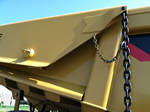 |
| Tailgates with durable components, such as steel alloy chains, last longer and perform better. |
What if there was a simple solution for increased efficiency and reduced maintenance – all while putting more money in the company’s pocket?
While it might seem like a small feature, not having a tailgate often results in loads that are typically 10-15 percent below rated capacity. Though not intentional, loading a unit without a tailgate to prevent spillage out the back and over the side results in less material in the truck bed. Sacrificing 15 percent rated capacity per load each trip is simply not affordable.
Hauling a half-full load costs relatively the same amount in labor, fuel and truck maintenance as hauling a full load. Tailgates quickly and easily boost an operation’s profitability because loads achieve rated capacity. For example, a 100-ton-capacity truck with a tailgate hauls nearly 15 more tons per load than a 100-ton truck without a tailgate.
If a fleet of eight trucks adds 15 tons to each of their respective 10 loads per day, an additional 1,200 tons of material moves daily. That equates to nearly $12,000 in profits if hauling aggregates at an average price of $9.95 per ton. It’s like adding another truck to the fleet without the increase in fuel, maintenance or labor.
 |
 |
| It’s important to find a tailgate that lifts high enough to avoid damage and carryback. |
Widen the Target
Capacity is only part of the equation. Tailgates not only allow for maximum payload, but also provide the loader-operator a bigger loading target, than they enhance speed and efficiency while reducing wear and stress on the truck. Loaders can dump materials in the middle of the body, rather than near the front, improving weight distribution and overall truck stability. Loader-operators avoid spillage by placing most or all of the materials toward the front of the bed when there’s no tailgate. This technique ends up overloading and stressing the front axles and hydraulic hoist cylinders of the truck, resulting in premature tire wear, body maintenance, as well as potential axle and hoist cylinder damage.
Typically, rigid-frame haul trucks carry one-third of the weight on their front axle and two-thirds on the back. Dumping heavy materials toward the front puts immoderate stress on the chassis, axles, front tires, suspensions and hydraulic systems. Front tires can only support so much weight before they blow or rim damage occurs.
Sometimes tires can be salvaged, patched or re-treaded, but even repairs are expensive, costing up to 60 percent of their original cost. An optimized loading target, equalized weight distribution and reduced spillage means that trucks with tailgates can extend a tire’s service life by as much as 40 percent or up to 13,000 hours in some cases.
Take Control of Maintenance
Remember that just because a truck has a tailgate, doesn’t mean it can be overloaded. A 100-ton truck cannot haul 110 tons of material without operating outside of the OEM truck manufacturers guidelines; this causes damage and safety hazards in addition to voiding the truck warranty. Squeezing an extra 10 tons in a load might seem like a quick way to bring in extra profits, but repair costs far exceed the additional revenue if you blow a tire or cripple the chassis and axles.
 |
| Quarry managers rely on tailgates to increase load volume and jobsite productivity. |
In some large mines, maintenance crews replace more than 200 tires per month because of debris damage or overloading. Most mining truck tires cost upward of $10,000 apiece, with some larger models topping out at $100,000 each. Combine those extra costs with downtime caused by the repairs and replacement, and the impact can be devastating.
Let’s look at the numbers:
The return on investment associated with a tailgate is significant, and scissor-style tailgates take it even further. From increased volume and reduced maintenance to fast load dumping and safe operations, an off-highway tailgate quickly pays for itself, even with the average cost between $18,000 to $28,000 – based on the size of haul truck and optional features. Eight, 100-ton-capacity trucks hauling aggregates bringing in approximately $11,940 in additional profits per day will start seeing an ROI on the purchase of the eight tailgates after roughly 20 days from the volume boost alone, not to mention the additional fuel and tire cost savings associated with the addition of tailgates to a truck fleet.
There is a simple solution for boosting profits, all operations need to do is keep the rocks in the box.
Josh Swank is vice president of sales and marketing for Philippi-Hagenbuch Inc.

